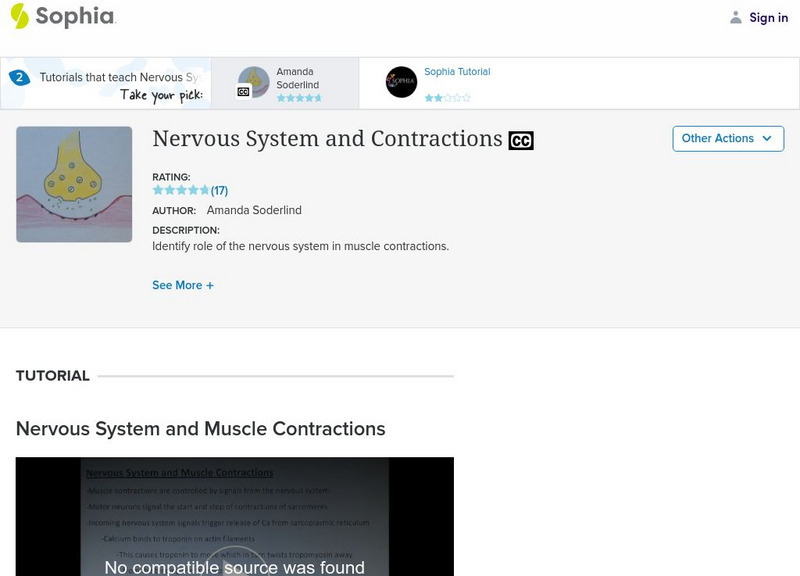Catalyst University
The Sliding Filament Mechanism EXPLAINED! - with Animation
In this video, we will discuss the structure of the sarcomere and see how that relates to sarcomere shortening (with animation).
Mazz Media
Muscle Function
This live-action video program is about muscle function. The program is designed to reinforce and support a student's comprehension and retention of the term through use of video footage, photographs, diagrams and colorful, animated...
Professor Dave Explains
Types of Tissue Part 3: Muscle Tissue
With epithelial tissue and connective tissue down, it's time to learn about the third type of tissue, and that's muscle tissue. This makes up all the muscles in our bodies, and it comes in three types. Those are skeletal muscle, cardiac...
Professor Dave Explains
The Mechanism of Muscle Contraction: Sarcomeres, Action Potential, and the Neuromuscular Junction
We've learned about the types of muscle, including skeletal muscle, and we know then when these muscles contract, we are able to move our bodies around. But how exactly does this happen on the molecular level? There is an astonishing...
Bozeman Science
Muscular System
To take one step, the body uses about 200 muscles. In the video, learners see the difference between the three types of muscles found in the human body—skeletal/striated, smooth, and cardiac. The instructor then explains, in detail, how...
Curated OER
The Muscular System
Muscles and the chemicals myosin and actin are described in the sliding filament theory by Paul Andersen using pictures on his Smart Board. Give your young scientists a clear idea of muscle contraction by showing this video.
Khan Academy
Role of the Sarcoplasmic Reticulum in Muscle Cells, NCLEX-RN
Many of the concepts mentioned as an aside in previous videos are reintroduced here. By listening to Salman's recap of an action potential, students will understand how a nerve impulse can stimulate the release of neurotransmitters which...
Crash Course
Muscles – Muscle Cells (Part 1)
As part of a study of muscles and muscle cells the narrator of this insightful video begins by reviewing the three types of muscle — smooth, cardiac, and skeletal. He then explains how actin and myosin play important roles in those...
Curated OER
Skeletal Muscle Structure
Skeletal or striated, muscles are shown down to the chemical components. All the fibers that make up a muscle cell are described and animated. Use this to illustrate the parts of skeletal muscles for your anatomy or biology classes.
Curated OER
Muscular System Structure and Function
A slide show on the muscular system is narrated, discussing the types of muscles and their functions. The muscle is shown in all its parts; the narrator briefly touches on filaments and contraction.
Curated OER
Human Body - Strength - Part 2/4
When a hiker gets trapped under a one-and-a-half ton piece of sandstone, he is shockingly able to throw off the slab. Because we normally use only one-third of our muscle fibers at a time, the potential for more is available in...
Khan Academy
Khan Academy: Biology: Myosin and Actin
The process of how two proteins can interact with one another to produce mechanical motion. [9:38]
Khan Academy
Khan Academy: Preload and Afterload: Frank Starling Mechanism
Carefully follow five different preload scenarios to see how each one will have a different effect on how actin and myosin line up. Rishi is a pediatric infectious disease physician and works at Khan Academy. [14:18]
Khan Academy
Khan Academy: Preload and Afterload: Preload Stretches Out the Heart Cells
Find out why stretching a heart cell in diastole affects how forcefully it contracts in systole. Rishi is a pediatric infectious disease physician and works at Khan Academy. [12:41]
Khan Academy
Khan Academy: Heart Muscle Contraction: Calcium Puts Myosin to Work
See exactly how calcium binds troponin-C and allows myosin to do some work. Rishi is a pediatric infectious disease physician and works at Khan Academy. [10:03]
PBS
Pbs Learning Media: Crash Course Anatomy and Physiology: Muscles, Part 1: Muscle Cells
We're kicking off our exploration of muscles with a look at the complex and important relationship between actin and myosin. Your smooth, cardiac, and skeletal muscles create movement by contracting and releasing in a process called the...
Sophia Learning
Sophia: Nervous System and Contractions: Lesson 1
This lesson will investigate the role of the nervous system in muscle contractions. It is 1 of 4 in the series titled "Nervous System and Contractions."
Sophia Learning
Sophia: Muscle Contractions: Micro Level: Lesson 1
This lesson will go into more detail describing how a muscle contracts. It is 1 of 4 in the series titled "Muscle Contractions: Micro Level."
Crash Course
Crash Course A&p #21: Muscles, Part 1 Muscle Cells
We're kicking off our exploration of muscles with a look at the complex and important relationship between actin and myosin. Your smooth, cardiac, and skeletal muscles create movement by contracting and releasing in a process called the...
Khan Academy
Khan Academy: Preload and Afterload: Increasing the Heart's Force of Contraction
Find out exactly how stretch increases force of contraction in end-diastole, whereas more calcium increased force of contraction in end-systole in this video lecture. [14:29]
Khan Academy
Khan Academy: Preload and Afterload: Active Contraction vs. Passive Recoil
Go through the similarities and differences between the sarcomere and a slingshot! This video explores a contraction in terms of what happens to the interaction between actin and myosin and the length of the sarcomere. Then the video...
Khan Academy
Khan Academy: Heart Muscle Contraction: Sympathetic Nerves Affect Myosin
Check out how the amount of Myosin that is tugging on your heart can change depending on your activity level. Rishi is a pediatric infectious disease physician and works at Khan Academy. [12:02]
Khan Academy
Khan Academy: What Is Contractility?
A video [13:44] that explains what contractility is and how it works to send messages through the sympathetic nervous system.




















